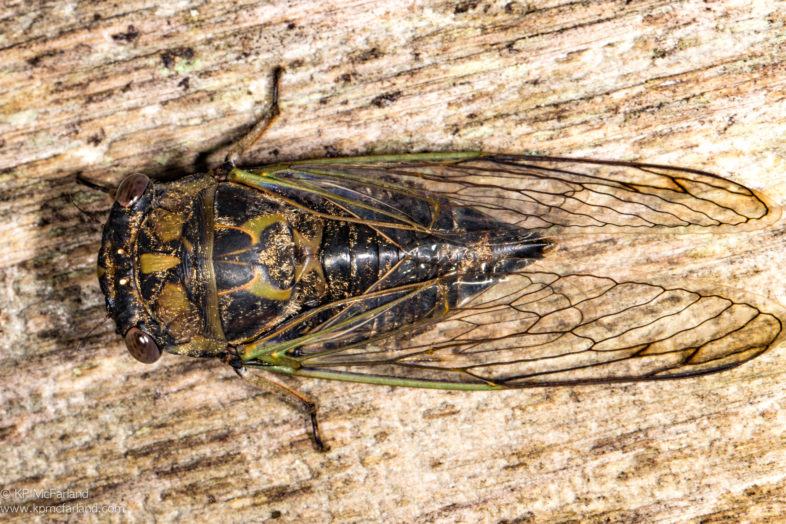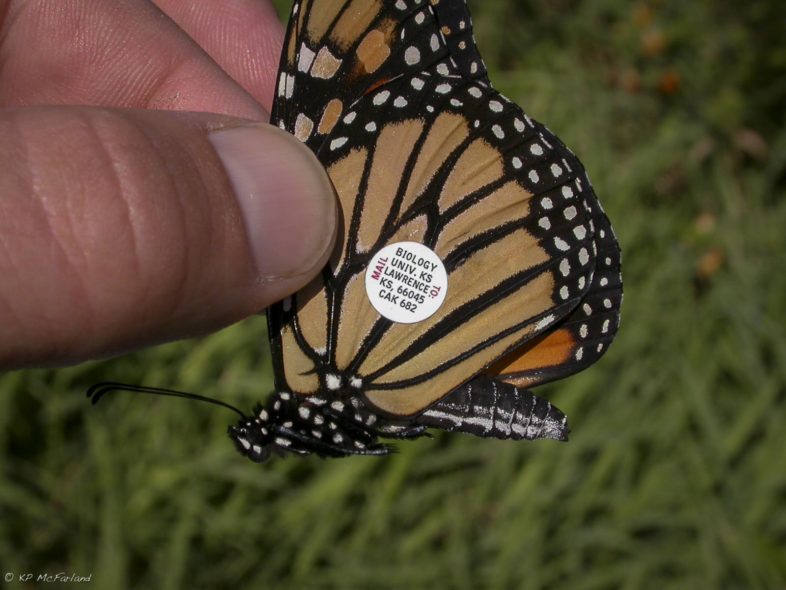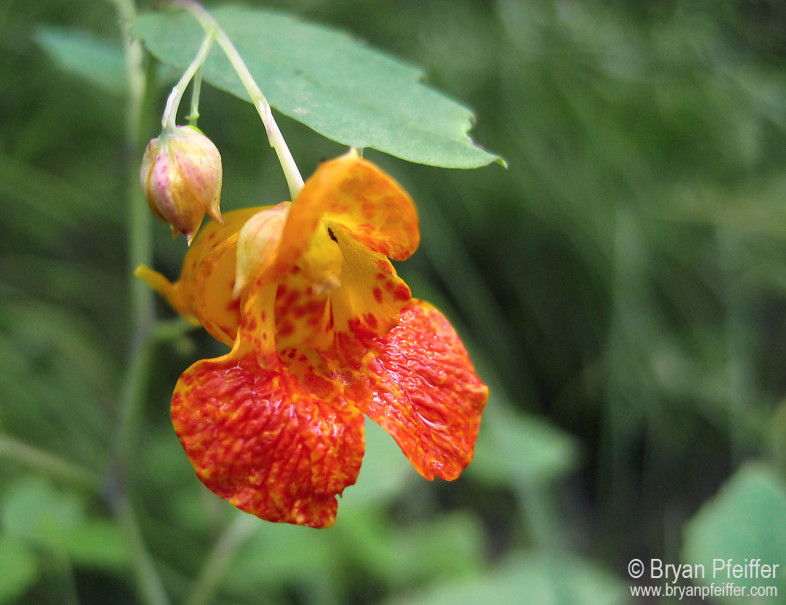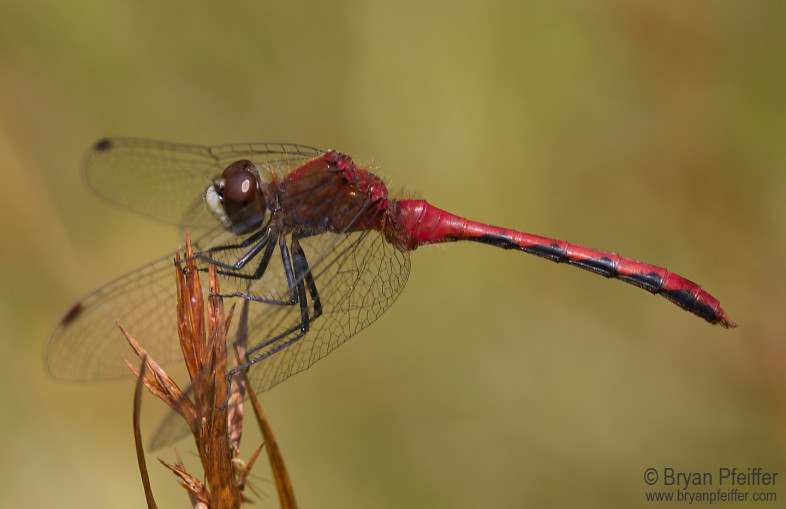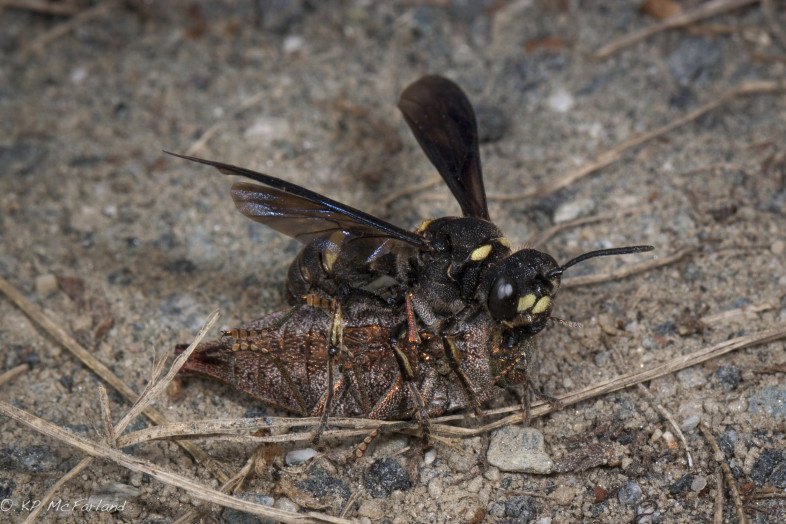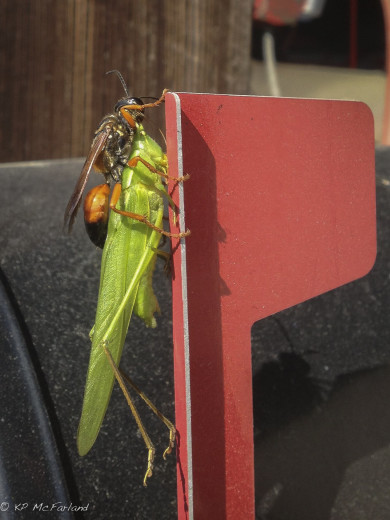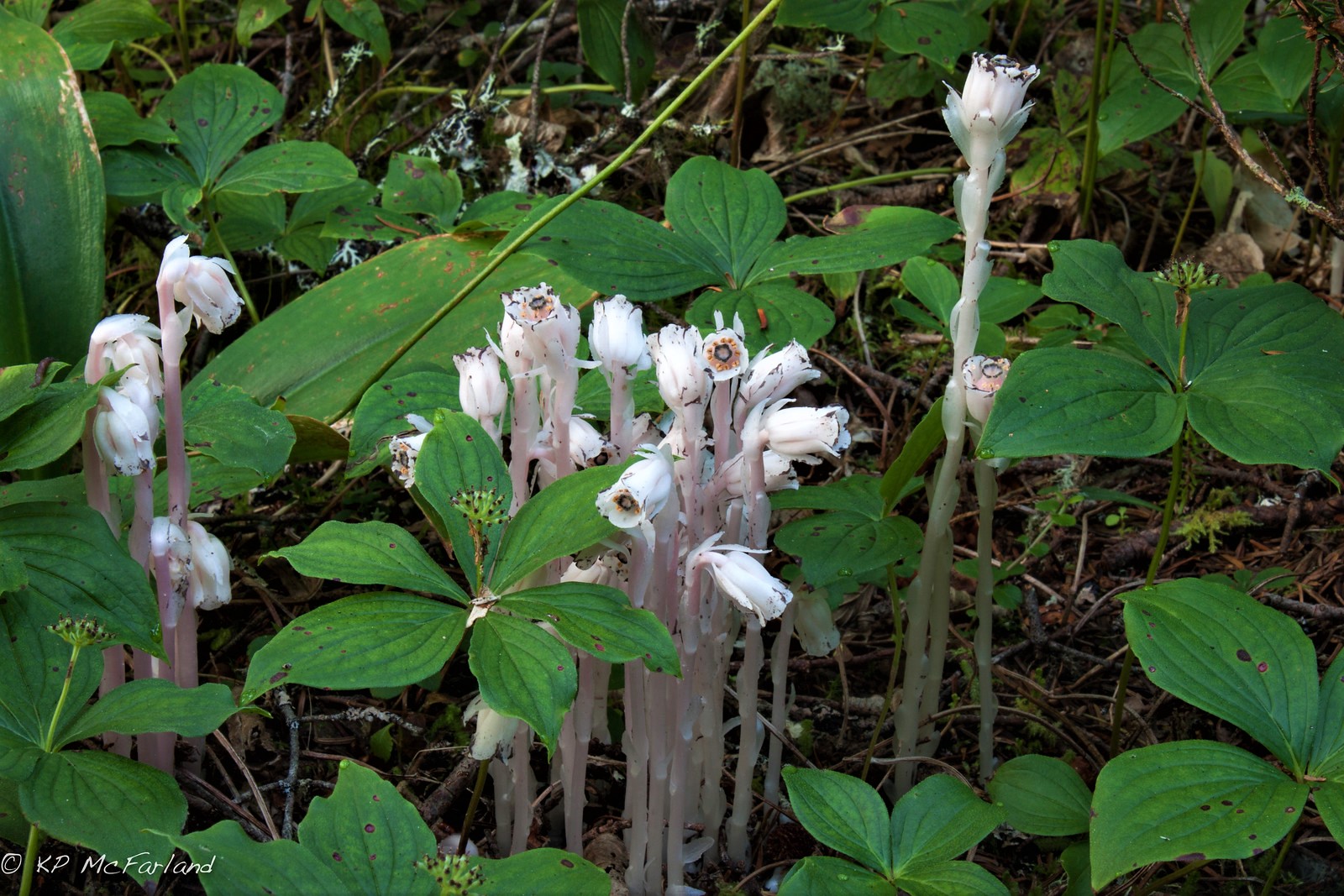
Indian Pipe, also known as Ghost Pipe, sticks its pale, non-photosynthetic stalks and flowers up through the forest floor in late summer. / © K.P. McFarland
By Nathaniel Sharp and Kent McFarland
FEAR NOT— we’ve still got plenty of summer here in Vermont and points north. So in this edition of VCE’s monthly field guide to nature, we’ll celebrate a few audacious summer insects. But we’ll also alert you to animals on the move. Yeah, the “M-word.” So if you’re not quite ready for fall migration, well, sorry… too late.
Bird Migration in August?
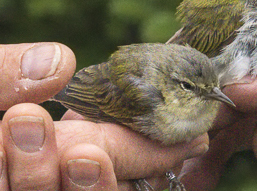
Adult female Tennessee Warblers mist-netted and banded on Mt. Mansfield, VT, 28 July 2016. / © Chuck Gangas
Afraid so. Take Tennessee Warblers, for example. They blast through Vermont in May on their way to boreal forests to breed, and now they’re trickling back through on their southward journey to wintering grounds in northern South America. “Fall” migration can begin for some individuals as early as July. They are gone long before Staghorn Sumacs and Red Maples catch fire and draw busloads of human migrants to Vermont. That’s one of the dirty little secrets about fall migration—it actually begins in summer. To be sure, these Tennessee Warblers are an early “fall” migrant, but it is by no means unusual. If you wait until next month for shorebirds, for example, you will have missed a huge part of their migration. Many have been departing Arctic breeding grounds since mid-July. Be sure to add your bird observations to Vermont eBird, a project of the Vermont Atlas of Life, to help us track their populations.
The Buzz on Northern Dog-day Cicada
The dog days of summer are upon us and so is the buzzing sound of the Northern Dog-day Cicada. Males are calling to females with a high-pitched buzz lasting about 15 seconds. It starts softly, gets louder, then tapers off—the only species in this area that sounds like a buzz saw.
These lazy, hot, dog days of August are named for Sirius (the “dog star”) in the constellation Canis Major. Sirius appears in northern skies around the same time that this cicada emerges and starts singing.
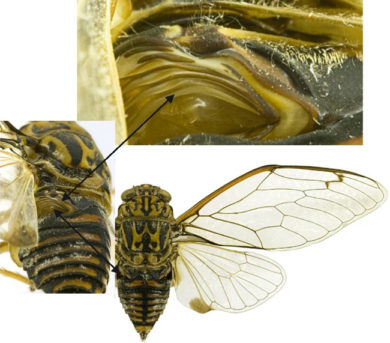
Close up of male cicada tymbal./ © Landcare Research New Zealand Ltd [CC BY 4.0 ]
Female cicadas use their ovipositor to saw small gashes into tree twigs, where they lay eggs. After about six weeks the nymphs hatch, drop to the ground, burrow down to a tree root and suck its juices for about three years to maturity. Then one July or August day, Dog-day Cicadas crawl out of the ground and climb up tree trunks as mature nymphs, where they split open and emerge as adults with long wings and bulging eyes—only to live for a few weeks.
Hear cicadas or other insects singing? Make a recording with your smartphone and submit them to the Vermont Atlas of Life iNaturalist project. Its fun and easy!
Monarchs Begin to Make Their Move
The Monarch flaps in my net as I reach in and carefully pull it out. I peel an adhesive tag the size of my small fingernail from a sheet and gently stick it on the middle of the butterfly’s wing. This monarch will now be known as CAK 682, the code on its new Monarch Watch wing tag. You can get tags too and help track their flight.
Where is this Monarch headed? Perhaps to the mountains of central Mexico where they overwinter at just 13 known sites. (A 1984 study found that there may have been as many as 60 overwintering sites, but commercial logging has eliminated many.) A single site may contain millions of Monarchs per acre and cover up to eight acres of forest.
The butterflies arrive from the north between November and late December and generally hang out on fir trees, metabolizing fat reserves that they built up during migration. Remarkably, they actually gain weight on migration and arrive on wintering grounds with fat reserves for the winter, unlike songbirds, which require huge fat stores to burn during migration.
Butterflies in overwintering sites begin to disperse in March and early April, and they then migrate to the Gulf Coast of the southeastern U.S., where females arrive just as milkweed is sprouting. They lay eggs on the fresh plants and then most butterflies die. One or two generations of Monarch caterpillars feed on milkweed before it becomes too hot and dry for the milkweed to persist. The newly minted adult butterflies then continue the northward migration and arrive in New England in June (sometimes May), just as our milkweed flourishes. The females lay eggs here and die.
It takes about 30 days to grow from Monarch egg to caterpillar. Beginning in mid-August, after several generations of monarchs have been produced here, decreasing daylight triggers a physiologic change in Monarchs, causing this generation to migrate back to the wintering sites in Mexico and complete the annual cycle. Incredibly, the adults that leave here have never seen Mexico—yet somehow they are guided back to these small sites.
Monarch GPS
How do Monarchs navigate to Mexico where their great-great-great-great grandparents wintered? Recent research has shown that Monarchs, using a clock in their antenna to keep time and eyes that record the azimuth of the sun, use a time-compensated “sun compass” to maintain a southwesterly direction during flight.
The winter generation of butterflies lives up to eight months while the successive spring and summer generations are lucky to live a single month. It takes four or five generations of spring and summer Monarchs to produce the final “super generation,” which migrates to Mexico in the fall and then back to the southern United States in spring.
How do we know that Vermont Monarchs actually make it to Mexico and are not enjoying the winter in Florida or the Caribbean where there are some resident, non-migratory Monarchs? One way is by tagging them.
With millions of Monarchs, the odds of a recapture are poor; however, there have been eight tagged Monarchs from Vermont found in Mexico. The first lucky tag was applied in Essex Junction on September 9, 1999, and the monarch was found in El Rosario, Mexico on March 1st, 2,320 miles away!
We also know that Monarchs from the Northeast winter in Mexico by testing their chemistry. Hydrogen isotope analysis shows that New England monarchs winter in Mexico. Rainwater contains slightly different amounts of these isotopes across North America, and this unique chemical signature is transferred from rainwater to milkweed to caterpillars to adult Monarchs. By selecting sites scattered across eastern North America, researchers have created a map displaying the chemical levels for each region. One study found that on average, only about 15% of the Monarchs overwintering in Mexico originated in the Northeast, while 38% are from the Upper Midwest.
Autumn Monarch migration begins at the very northern end of their range in mid-August and will be kicking into migration gear by the end of the month here in Vermont.
I check to make sure the tag has adhered to the Monarch’s wing. I note the date, location, and tag code in my notebook. The monarch flaps out of my grip and climbs high into the clear sky and glides out of sight. Maybe CAK 682 will be a lucky tag. Buen viaje, monarca!
Get Involved
It’s time for Mission Monarch across North America! Have you added a Monarch survey yet? It is so easy to do and takes as little as 15 minutes of your time! Find a milkweed patch of any size anywhere, survey the plants for eggs and caterpillars, add your data to Mission Monarch! And when Monarch migration begins, add your Monarch butterfly sightings to Journey North and help track their travels to Mexico.
Calling Katydids
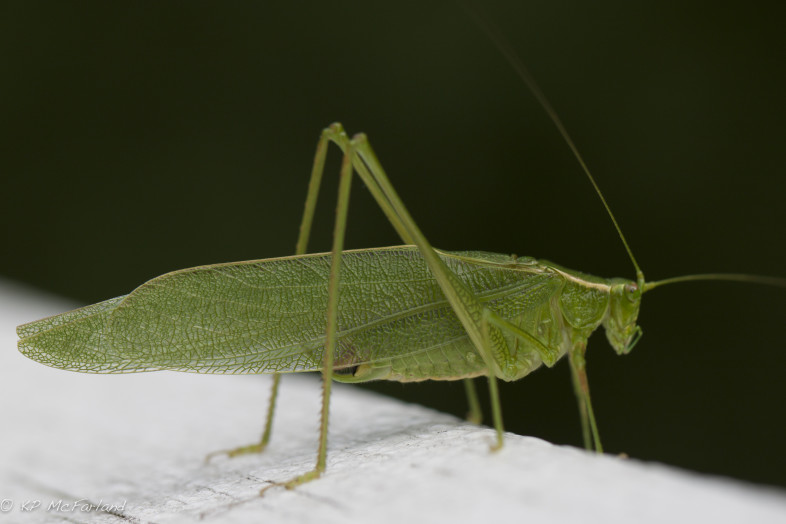
Katydid on a deck railing at night. / © K.P. McFarland
Crickets and katydids can evoke childhood memories of summer as we pause to listen to their distinct sound. Known to biologists as the order Orthoptera (or-THOP-tir-ah), they can be found all over the world, except at the poles. In Vermont there are 35 known species—15 crickets (one introduced species) and 20 katydids (three introduced species).
Stridulation
Katydids front wings feature a file and a scraper. The file looks a little like the teeth of a comb, and the scraper is just a sharp edge. To produce their familiar sound, they elevate their front wings and move them back and forth against each other, the scraper on one wing moving along the file of the other. This action makes membranes on the wings vibrate, which is the source of the sound we’ve been hearing since we were kids.
And, they listen to the sound with their legs. Katydids don’t have ears on the sides of their heads like we do, they have them on their knees… or their elbows… either way—they have an ear-like structure called a tympanum, which is a tiny oval cavity with a thin membrane stretched over it that vibrates in response to sound, much like our own eardrum.
Listen to Outdoor Radio to learn more about how crickets and katydids sing and the surprising way that they hear. Hold a leg up and listen to the show. Make recordings of these insects with your smartphone and upload them to our Vermont Atlas of Life project on iNaturalist.
A Tongue and a Flower
The Ruby-throated Hummingbird can extend and retract its tongue about 13 times a second. Jewelweed flowers take advantage of the scenario to dust the bird with pollen. Ruby-throated Hummingbirds are attracted to these orange-gold flowers. A single hummingbird can visit as many as 200 flowers in 15 minutes. They only get a small amount of nectar, the equivalent of about a few grains of sugar, from each flower.
Ethan Temeles and his students at Amherst College discovered that the jewelweed flower is specially adapted for the feeding style of the hummingbird. The only thing you might notice while watching one Ethan’s videos of a hummingbird feed at a jewelweed flower is that the flower shakes back and forth while the bird’s bill probes into the flower. This doesn’t seem like anything remarkable, but to the biologists it was a clue.
Apparently the flower movement is an adaptation to better smear pollen on the unsuspecting hummingbird. The jewelweed has a tiny opening that is only about four millimeters wide and the tube quickly narrows to only one millimeter wide and bends sharply down and then back toward the front of the flower. At the end of this tube is the liquid prize for the hummingbird: sweet nectar.
While the bird hovers it uses its long tongue to reach down into the flower tube. As the tongue gets to the sharp turn in the tube, it pushes the flower away. The tongue reaches the end of the tube and nectar flows into the channels on the tongue. The bird then pulls the tongue back to drink the nectar, releasing the pressure on the back of the flower tube.
The flower hangs from a stem with just enough tension to make the tongue’s movements spring the flower back and forth as the tongue goes in and out. When the flower springs back, pollen is brushed on top of the bill and forehead of the hummingbird. When the hummingbird visits another flower, the pollen it carries is brushed off and fertilizes the flower.
The “Hawks” of Your Meadow
They are the red dragonflies of summer—darting, posing, breeding, and killing small insects in a field near you. These are the meadowhawks—small dragonflies in the genus Sympetrum. Here in Vermont we find five members of this genus (one of which is black and yellow). The rest are mostly red and somewhat hard to differentiate (without a close look at their “private parts.”) But if you’re near a field that’s not too far from a lake or pond, you’re probably not too far from meadowhawks. Males tends to take favorite perches. So if you flush one from its spot on a goldenrod or a meadowsweet, hang out for a while and wait for it to return for a closer look. And if you find one that looks like a yellow version of the meadowhawk pictured above, it’s most likely a female or young male.
Learn about these and all the dragonfly and damselfly species found in Vermont on the Vermont Damselfly and Dragonfly Atlas, a project of the Vermont Atlas of Life, and add your sightings too!
Wild Wasp World
The Smoky-winged Beetle Bandit (Cerceris fumipennis) hunts for Jewel Beetles (Buprestidae). This wasp is a solitary ground-nesting species. Each female constructs and attempts to maintain a single subterranean nest. The nest is usually in loose soil or sand and in close proximity to others, forming a neighborhood. The nest’s entrance is easily visible, marked by a small circular mound of earth with a pencil-sized hole in the center.
A female wasp attacks its target by landing on it and grabbing it by the thorax with her mandibles. She then inserts her stinger in a gap in the beetle’s armor at the base of its leg and injects a paralytic venom. The wasp flies back to the nest with the beetle tucked under her body like a torpedo. She places each beetle in a small chamber and lays an egg on it before closing it off with a plug of dirt. The wasp larvae feed on the live beetle. Ten months later, the wasps emerge from the ground to mate and raise their young.
The wasp has an enemy to avoid. Female “satellite flies” (Miltogramminae) intercept prey-laden wasps and deposit eggs on the paralyzed beetles. The voracious fly maggots out compete the developing wasp larvae for paralyzed beetle food and the wasp larva dies of starvation. While netting bees for the Vermont Wild Bee survey, VCE biologist Spencer Hardy swung his net at a flyby wasp and managed to capture all 3 insects involved in this fascinating interaction. Check out his iNaturalist observation including a Smokey-winged Beetle Bandit, Buprestid beetle, and a couple of satellite flies.
Like police recruiting dogs for sniffing out illegal drugs, biologists have used this wasp to search for an introduced beetle called the Emerald Ash Borer (Agrilus planipennis). The first detection of this beetle in Connecticut was at a wasp nest under biosurveillance. Read more about Cerceris wasps from Northern Woodlands online, and check out more of Kent’s awesome images of these amazing insects.
Great Golden Digger Wasps (Sphex ichneumoneus) hunt for grasshoppers, katydids or crickets. With a sting, they paralyze their prey, place it in an underground chamber, and lay one egg on it. The victim stays alive, providing fresh food for the hatching larva to feed upon. House Sparrows (Passer domesticus) and American Robins (Turdus migratorius) have been observed chasing wasps carrying prey to their nests, causing them to drop the food, which the birds then grabbed and ate. The wasps produce one generation per year. The young wasps spend the winter in their nests and emerge the following summer.
Other wasp species specialize in hunting bees, stink bugs, cicadas, and other species for their young to feed on. It’s a dangerous world for unsuspecting insects.
